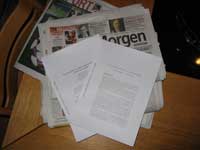Hectic
days ahead! Today, there is the Ph.D. defense of Stijn Symens and the
following two days there is a meeting in Ghent where Jacques
Alev and me organize a special session on non-commutative algebra. Here
is the programme of that section
Session 1 (Friday 20 May)
— chair : Jacques Alev (Univ. Reims)
15.30-16.25 : Iain Gordon (Glasgow, United
Kingdom) : “Rational Cherednik algebras and resolutions of
symplectic
singularities”
16.25-16.35 : break
16.35-17.30 : Olivier Schiffmann (ENS Paris, France) :
“Elliptic Hall algebras and spherical Cherednik algebras”
Session 2 (Saturday 21 May) — chair : Lieven Le Bruyn
(Univ. Antwerp)
14.30-15.15 : Markus
Reineke (Munster, Germany) : “Geometry of Quiver Moduli”
15.15-16.00 : Raf Bocklandt &
Geert Van de Weyer
(Antwerp, Belgium) : “The power of slicing in noncommutative
geometry”
Afterwards it will be time to take a short
vacation (and do some cycling in the French mountains). Here is my
reading list for next week :
The dark Eye – Ingrid
Black : Simply because I read her previous novel The dead…
Brass – Helen Walsh : I
read the first 3 or 4 pages in the shop and couldn\’t stop …
Fleshmarked Alley – Ian
Rankin : Hey, it\’s vacation!
